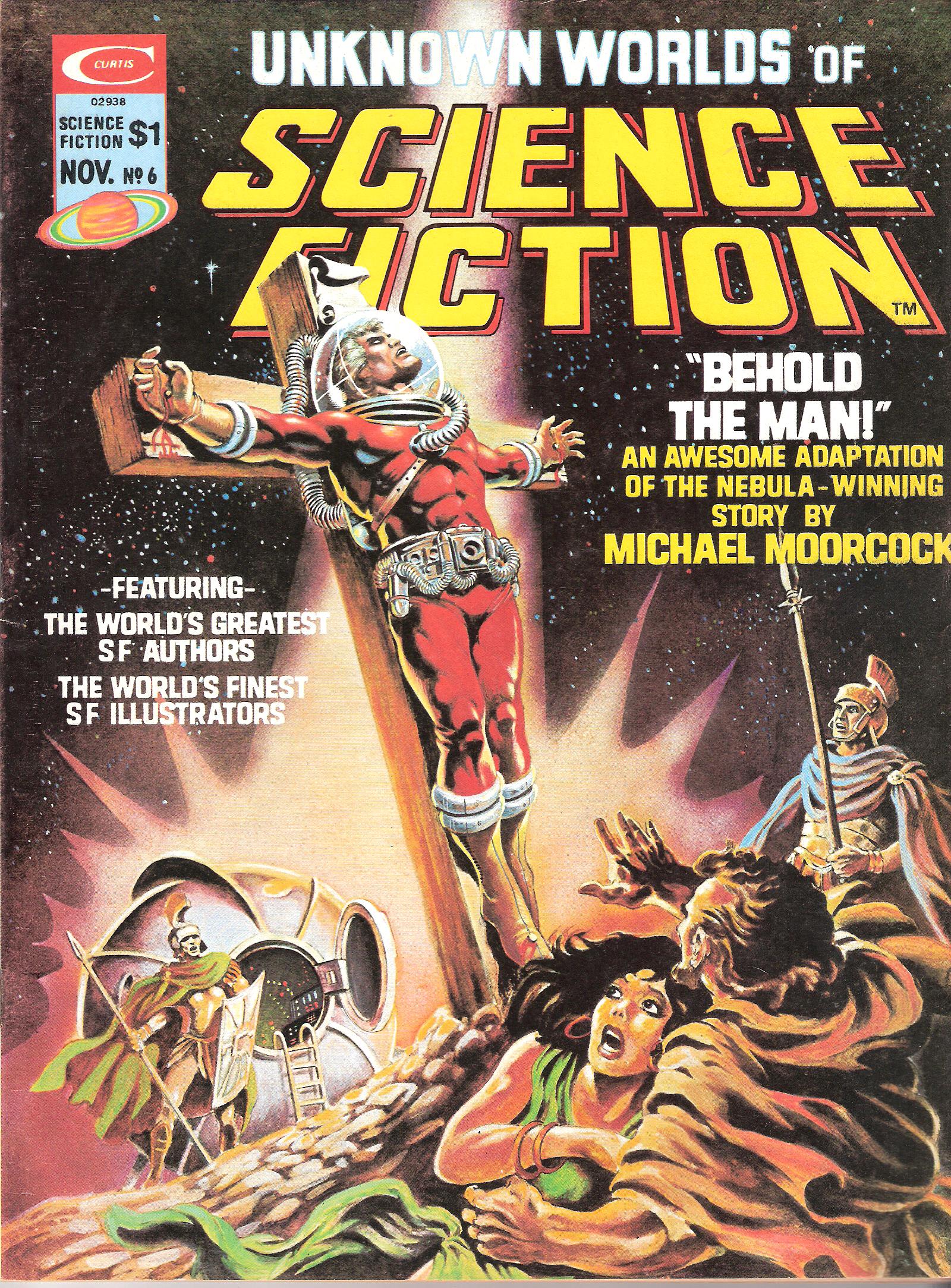THE STORY SO FAR: Bill Spangler is trying to perform the risky and technically-challenging multiple-part blog post. He’s been writing about author Michael Moorcock, and the various appearances Moorcock’s various characters have made in comic books. You can read parts one and two here and here. But can Bill stick the landing? Will the serum get through on time? And what about Naomi? NOW READ ON…
Many of Moorcock’s creations—like Elric and Corum and Hawkmoon—fit comfortably into the traditional genres of high fantasy or sword and sorcery.
And then there’s Jerry Cornelius.
I think the Jerry Cornelius stories can be described as an attempt to combine a traditional pulp hero (or super hero) with more modern styles of writing and characterization. Jerry’s adventures are usually set in the present, or the near future. He looks different nearly every time he appears. Moorcock calls him “a sort of everyman…seeking strategies for survival in a world that grows technically, if not more socially complex…”
Jerry’s career in comics began with The Adventures of Jerry Cornelius: The English Assassin, a comic strip that ran in a British underground newspaper called the International Times in 1970. Moorcock co-wrote the strip with novelist M. John Harrison and the art was contributed by Mal Dean and R. Glyn Jones.
Like the Cornelius prose stories, it’s hard to describe what actually happens here. I can tell you that Elric makes a cameo appearance as does Moorcock himself. “The English Assassin” was reprinted in a collection of Moorcock’s short stories, My Experiences In the Third World War.
Cornelius also appeared in early versions of a serial written and drawn by Jean “Moebius” Giraud in the late 1970s. The serial ran in both the French magazine Metal Hurlant and it’s American counterpart, Heavy Metal. However, due to some sort of communications snafu between Moorcock and Moebius, Cornelius was edited out of the story. The title changed from The Airtight Garage of Jerry Cornelius to The Airtight Garage and Cornelius became Lewis Carnelian.
Roughly 10 years later, Jerry and his crew popped up as the supporting cast in The Saga Of the Man-Elf, a British comic that got some circulation here in America. Despite what the title suggests, “Man-Elf” resembles V For Vendetta more than Lord Of the Rings. A near-future Great Britain is controlled by a military government Miss Brunner, a regular character from the Cornelius prose stories, is the nominal head of the regime. But Jerry’s brother Frank actually holds the reins. There’s an active resistance, though, and the leader of the resistance is Janus Carpenter, who is rumored to be a human-extraterrestrial hybrid.
And what about Jerry? He’s an aging rock musician who has to decide whose side he’s going to be on in the upcoming fight (Spoiler: he makes the right decision.) This limited series was written by Guy Lawley and drawn by Richard Weston.
More recently, Cornelius was incorporated into The League of Extraordinary Gentlemen, Alan Moore and Kevin O’Neill’s love letter to British pop culture. Early in The Black Dossier, in a scene set in 1958, Allan Quartermain and Mina Murray share a scene with Jerry’s mother and his sister Catherine. Jerry and Frank are mentioned, but don’t come on stage. The adult Jerry makes an appearance in 1969, the second volume of the Century limited series. I don’t have an explanation for his appearance here, but I can tell you it’s consistent with the way he looks in A Cure For Cancer, the second Cornelius novel.
Oh, nearly forgot: Michael Kane, the hero of a trilogy of Edgar Rice Burroughs pastiches that Moorcock wrote, is mentioned in the first issue of the second LXG limited series. But he doesn’t have a role in the story.
Back in “The English Assassin” newspaper strip, Moorcock’s character is called Sgt. Glogauer. That’s a reference to Karl Glogauer, the protagonist of two of Moorcock’s novels, Behold the Man and Breakfast In the Ruins. Glogauer himself made it into comics in 1975, when a short version of Behold the Man was adapted for Unknown Worlds of Science Fiction, a black-and-white magazine published by Marvel.
Before we go any further, a few words of Fair Warning: Behold the Man makes some arguments about the nature of Jesus and of religious belief that some Christians may find offensive. I’m not saying Read It or Don’t Read It; I’m just trying to describe what you can expect, if you do read it.
As far as the comic book goes, the story is adapted by veteran writer Doug Moench—you can read my interview with Moench here—and the art is provided by Alex Nino. The art is something of a departure of Nino. At the time, he tended to use a lot of irregularly-shaped panels on a page, creating a complex layout. Here, though, he sticks to simple, rectangular panels.
Two of Moorcock’s more recent comic book projects do feature some of his best known characters. However, they deal more with the concept of the multiverse than with individuals, so I decided to save them until now.
In the late 1990s, as part of DC’s ill-fated Helix imprint, Moorcock wrote a 12-issue limited series called Michael Moorcock’s Multiverse. For most of those 12 issues, the comic was divided into three series, each with his own artist.
Walter Simonson illustrated the adventures of Jack Karaquazian and other characters introduced in Moorcock’s “Southern” fantasies, Blood and The War Amongst the Angels. Mark Reeve was the artist for Sexton Begg, a gentleman detective and John Ridgway provided the art for Duke Elric, a version of Elric set in recorded history, rather than a totally imaginary world. By issue 12, however, these three seemingly parallel plotlines meet and the last issue is a full-length story
I like the structure of “Multiverse” and the fact that issue 12 bears a strong resemblance to an old-school underground comic. But it’s probably not as accessible as it could be. Elric: The Balance Lost does a better job introducing the Multiverse and the battle between Law and Chaos. This is another 12-issue series, published by Boom! Studios in 2011 and 2012. The story was developed by Moorcock and Chris Roberson (iZombie, Masks and the Mysterious Strangers, among others), while Francesco Biagini provided the art.
This time, Elric, Hawkmoon, Corum and a new facet of the champion, Eric Beck, join forces to defeat a plot of the Lords of Law. (That’s right, Law; they’re trying to maintain the balance, after all. )Some of the characters and concepts from Blood play a role, and there are cameos from quite a few other characters including Oswald Bastable, Una Persson, Catherine Cornelius and the Masked Buckaroo.
If there are other Moorcock-related comics in the works, I don’t think they’ve been announced yet. Personally, I think a comics publisher could do well with Oswald Bastable’s solo adventures—The Warlord of the Air; The Land Leviathan and The Steel Tsar—given the current popularity of steampunk. In any case, I think the Eternal Champion and comics are good fit, and their relationship is far from over.












